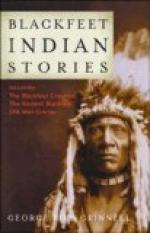The outside of the lodge was often painted with mysterious figures which the lodge owner believed to have power to bring good luck to him and to his family. Sometimes these figures represented animals—buffalo, deer, and elk—or rocks, mountains, trees, or the puff-balls that grow on the prairie. Sometimes a procession of ravens, marching one after the other, was painted around the circumference of the lodge. The painting might show the tracks of animals, or a number of water animals, apparently chasing each other around the lodge. On either side of the smoke hole at the top were two flaps, or wings, each one supported by a single pole. These were to regulate the draught of the fire in case of a change of wind, and the poles were moved from side to side, changing as the direction of the wind changed. On such wings were often painted groups of white disks which represented some group of stars. At the back of the lodge, high up, just below the place where the lodge poles cross, was often a large round disk representing the sun, and above that a cross, which was the sign of the butterfly, the power that they believe brings sleep. From the ends of the wings, or tied to the tips of the poles which supported them, hung buffalo tails, and sometimes running down from one of these poles to the ground near the door was a string of the sheaths of buffalo hooflets, which rattled as it swung to and fro in the breeze.
Their arms were the bow and arrow, a short spear or lance, with a head of sharpened stone or bone, stone hammers with wooden handles, and knives made of bone or stone, and if of stone, lashed by rawhide or sinew to a split wooden handle.
The hammers were of two sorts: one quite heavy, almost like a sledge-hammer or maul, and with a short handle; the other much lighter, and with a longer, more limber handle. This last was used by men in war as a mace or war club, while the heavier hammer was used by women as an axe to break up fallen trees for firewood; as a hammer to drive tent-pins into the ground, to kill disabled animals, or to break up heavy bones for the marrow they contained. These mauls and hammers were usually made by choosing an oval stone and pecking a groove about its shortest diameter. The handles were made by green sticks fitted as closely as possible into the groove, brought together and lashed in position by sinew, the whole being then covered with wet rawhide tightly fitted and sewed. As the rawhide dried, it shrunk and strongly bound together the parts of the weapon.
The Blackfeet bow was about four feet long. Its string was of twisted sinew and it was backed with sinew. This gave the bow great power, so that the arrow went with much force. The arrows were straight shoots of the service berry or cherry, and the manufacture of arrows was the chief employment of many of the men of middle life. Each arrow by the same maker was precisely like every other arrow he made. Each arrowmaker tried hard to make good arrows. It was a fine thing to be known as a maker of good arrows.




